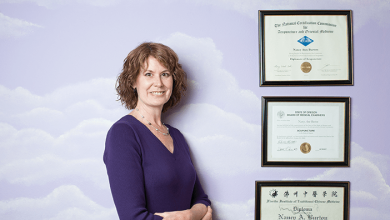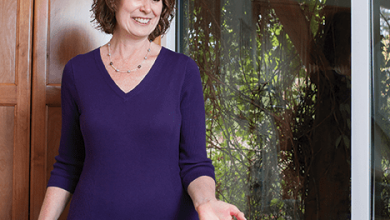Acupuncture: What’s the Point?
I’ve discussed the importance of eating foods rich in vitamins, minerals, amino acids and good fats to nourish and heal the body. I’ve written about the necessity not only to ingest nutritious foods but to make sure your digestive system is able to break down your food, filter out the water and waste, and deliver the nutrients to the blood. The third step of the journey is for the blood to deliver the nutrients to the various parts of the body. That’s where acupuncture comes in.
The oldest acupuncture needles ever found are made of stone and bone. Tests date them to 5,000 years ago.
In the 1940’s, Dr. Reinhold Voll, a medical doctor and engineer from Germany, proved that humans have electricity running through their bodies. Lo and behold, it runs right where the Chinese have been saying it did for thousands of years. The channels, also called meridians, don’t follow nerve pathways, as once hypothesized, but have their own routes throughout the body. Each of the main twelve channels starts at the tips of the fingers or toes and runs up or down the arms and legs, connecting on the chest, the head, or the back.
Various points on the channels are referred to as river, stream, spring or well points because the current running through the channels is like the current running through various bodies of water. The current, or Qi (pronounced ‘chee’), pushes the blood, just as the current in a river or stream pushes the water. If the Qi isn’t flowing as it should, neither will the blood. If the blood isn’t flowing freely, to nourish the organs and tissues, it can cause health problems or pain.
A dam in a river or stream causes a great deal of pressure to build up behind it. When there’s a blockage of Qi in an acupuncture channel, just like a dam, that pressure can cause pain, tremors, or impairment of function due to lack of nutrients further down the channel. When any part of the body needs to heal, increasing the flow of energy to that area increases the blood flow and therefore the amount of nutrients delivered. You can see how this would facilitate and accelerate the healing process for any condition.
Most of the twelve major acupuncture channels are related to various organs. The Lung, Heart, Liver, Spleen and Kidney channels are considered Yin, because fluids flow through these organs. The Large Intestines, Small Intestines, Gallbladder, Stomach, and Urinary Bladder channels are Yang, because those organs contain the fluids. Each of these organs is also associated with certain emotions. The Lung with grief, the Heart with anxiety, also over-joy which can create anxiety, the Liver with stress (projected outward is anger or irritability, and inward is depression), the Spleen with overthinking or overworrying, the Kidney with fear. There are also Pericardium and San Jiao “Triple Burner” channels. The San Jiao, along with the Ren, i.e. CV (Conception channel), and the Du, i.e. GV (Governing Vessel) channels, do not correspond to an organ.
There are 360 acupuncture points on the body, not including extra points, ear points or scalp points.
TCM (Traditional Chinese Medicine) doesn’t separate physical and emotional problems. Either can create or contribute to the other. Western medicine now attributes stress to a wide range of health issues, and respiratory issues are commonly seen in widows or any person dealing with profound grief. When a patient receives acupuncture it not only helps them physically but also emotionally.
Most people feel a deep sense of relaxation during treatment. This means they have gone into an Alpha State. Western tests have demonstrated when people are in this state they heal at an accelerated rate.This is why meditation, yoga, Tai Chi, and Qi Gong are so beneficial, when used to enter the Alpha State. After acupuncture, patients generally report continued relaxation and a sense of wellbeing.
I usually see patients once per week until their health issues are resolved, or well on their way to being so. Each week it’s normal to see improvements. Multiple issues are common. As opposed to Western medicine, which addresses each symptom separately, the more symptoms a patient reports, the more obvious the underlying condition creating these problems. It’s always fun to see an extensive list of symptoms dwindle and then disappear with each treatment, as the root cause of the problem is resolved.
In China, students learn the name of the points, which can describe the position or function of that point. In other countries we number the points according to their sequence on the channel, and abbreviate the name of the channel. For instance, ‘Walks Three Miles’ is ST 36 (Stomach 36). Armies in China used to march as far as they were physically able. They would then needle this point and could walk an additional three miles. The point helps energy, digestion and the immune system. Tests show that needling ST 36 also increases the white blood cell count.
There are point prescriptions, combinations of acupuncture points, for just about every ailment. As you can imagine, 5,000 years was sufficient to figure out quite a bit. Single points can be very powerful as well. Here are a few that everyone should know. You can use Google images to look them up online and see pictures of where these points are located. Massaging these points, lightly if they are sensitive and then deeper as tolerated, can bring significant relief. Except for points on the Ren (main Yin) and Du (main Yang) channels, which run up the midline of the front of the torso and the midline of the back, the points are bilateral. So you can massage the point on either side of the body, or both sides; whichever is easiest.
Du 26, Ren Zhong, which means Man Middle, or middle of the man, connects the Yin and Yang channels. It’s two-thirds of the way from the upper lip’s superior edge to the midline base of the nose. Its effective for fainting, unconsciousness, convulsions, shock, uncontrollable crying, and extreme back pain, to name a few uses. Massaging this point, or even stimulating it with your fingernail, can be helpful in times of emergencies, or if standing up quickly causes light headedness.
Lu 1, Lung 1, can stop respiratory distress faster than an inhaler. If you cross either hand over your chest. Put your fingers in your armpit. Run your thumb over the muscle between your armpit and chest, up to the place it naturally finds an indentation on the chest, beside the ribs, the most tender point is Lu 1.
Shen Men, on the ear, is for relaxation or to alleviate agitation. Put the tip of your finger on the top of your ear. Bring it down over the edge and forward, towards the front of the ear. Your finger will slide into a little indentation, called the triangular fossa, which is shaped like a triangle. Your fingernail should be on Shen Men, which means “Spirit Gate.”
P6, Pericardium 6, for nausea, or angina: heart pain. Hold your hand palm up. Two of the patient’s thumb widths up from the crease of the wrist, between the tendons is P6. Drug stores now carry Sea Bands for sea, car or air sickness. They are stretch bands that are placed around your wrist, with a small plastic ball that fits over P6, for prolonged stimulation. But when Sea Bands aren’t handy just massaging P6 can save the day.
LI 4, Large Intestines 4 is a point many people are already familiar with. It’s on the back of the hand. Follow the bones of the thumb and index finger down to where they meet. In the V between the bones is a tender point, LI 4. This point moves the energy in the upper body. It can be massaged for headaches, toothaches, sore throats, or any upper body discomfort. This point, and various others, should be avoided during pregnancy.
Liv 14 is where the Liver channel ends. It’s directly under the nipples about where the bra band would hit, if you wore one. The Liver channel is responsible for circulating all the energy in the body. When it isn’t flowing as it should people can get wound up, stressed out, irritable, or depressed. It can also cause the type of insomnia where the energy goes up at night, so the mind is too busy to sleep, and down during the day, making people tired. It can also cause a tight feeling, a band around the chest, like your bra is too tight if you wear one, though you know it’s the right size. Most acupuncture points are bilateral: the same on both sides of the body. The Liver channel starts in the big toes, runs up the legs and ends on the chest on either side of the stomach. If the Liver Qi is flowing up, instead of circulating as it should, it can catch the Stomach energy, which should be going down. The reverse flow of Stomach energy can cause ‘Rebellious Stomach Qi’. This includes hiccoughing, burping, vomiting, nausea, lack of hunger, and acid reflux. Massaging Liv 14 can help. This point is very effective for people in chemotherapy who get the hiccoughs that otherwise won’t stop, sometimes for months.
Acupuncture charts, showing all the channels on the body, are available on Google Images. You can also look up the separate channels.
Acupuncture needles are about the size of a hair shaft. During a treatment a patient lays on a massage table, with heat lamps to keep them warm, and the needles are inserted. Patients then relax for 15 to 30 minutes, in a darkened room, with soothing music if desired. “Already?” “It feels like you just put them in.” “Can’t you just leave me here all day,” are a few comments I frequently hear when I re-enter the treatment room to remove needles.
Pain was the first thing that the AMA (American Medical Association) acknowledged that acupuncture excelled at treating, though most patients feel some immediate relief after each treatment for whatever health issue they are coming for.
For patients who are needle phobic most acupuncturists can use acupressure, electric stimulation or micro-current on the points. Some of my most needlephobic patients eventually want to try a needle and then became the biggest fans of acupuncture. It’s important to treat patients in a way that suits them.
So to sum things up: What’s the point of acupuncture? There are three steps of healing: 1) Ingesting Nutrients, 2) Assimilating Nutrients and 3) Delivering Nutrients to the affected areas. acupuncture puts step 3, the delivery system, on the fast track, overnight express as opposed to 7-10 day ground. The specific acupuncture points insure the energy and nutrients are delivered to precise locations, break through barriers inhibiting delivery, and treat the root cause of the problem to alleviate symptoms. Get the point?
Health & Happiness,
Nancy Burton, L.Ac. ( Licensed Acupuncturist)


